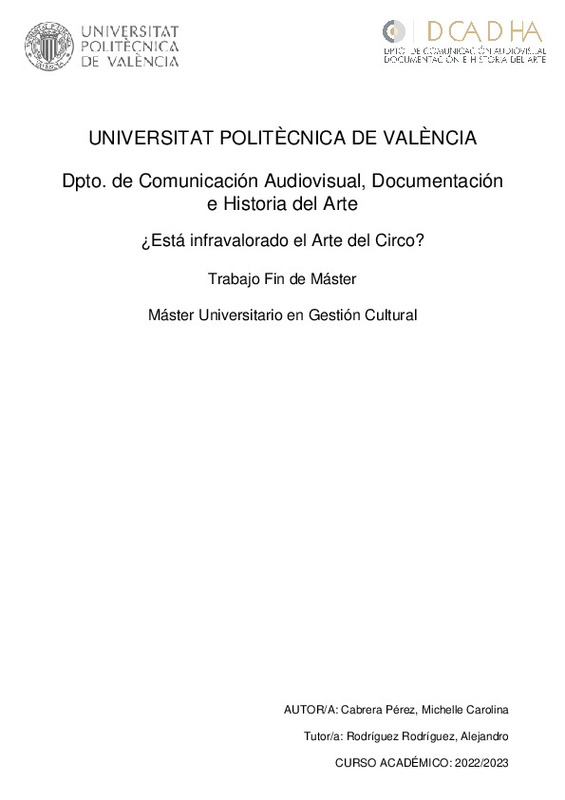JavaScript is disabled for your browser. Some features of this site may not work without it.
Buscar en RiuNet
Listar
Mi cuenta
Estadísticas
Ayuda RiuNet
Admin. UPV
¿Está infravalorado el arte del circo?
Mostrar el registro sencillo del ítem
Ficheros en el ítem
| dc.contributor.advisor | Rodríguez Rodríguez, Alejandro
|
es_ES |
| dc.contributor.author | Cabrera Pérez, Michelle Carolina
|
es_ES |
| dc.date.accessioned | 2023-09-25T08:28:09Z | |
| dc.date.available | 2023-09-25T08:28:09Z | |
| dc.date.created | 2023-07-17 | |
| dc.date.issued | 2023-09-25 | es_ES |
| dc.identifier.uri | http://hdl.handle.net/10251/197029 | |
| dc.description.abstract | [ES] Desde el antiguo Imperio Chino -donde ya se realizaban diversas actividades corporales técnicas y creativas- hasta la creación británica, en 1768, del Circo Moderno -el ideario circense más cercano que conoce la sociedad de masas-, la disciplina del circo se desarrolla como un arte escénico, como un espectáculo ingenioso, riguroso y atrevido que es capaz de envolver a las personas dentro de un mundo lleno de magia y de estupefacción. Entonces, ¿por qué existe actualmente un alto grado de desinterés hacia este arte ancestral? Y, peor aún, ¿por qué el sector circense vive en el margen de la precariedad en diferentes niveles? El objetivo principal de este trabajo es encontrar la respuesta a estas preguntas y, para ello, se analizan las investigaciones de otros/as autores/as con el propósito de realizar un recorrido a través de los orígenes de esta disciplina nómada, y el mundo interior que la conforma, así como su paso por España y su situación tanto legislativa como educativa en este país. | es_ES |
| dc.description.abstract | [EN] From the ancient Chinese Empire, where various technical and creative bodily activities were already taking place, to the British creation of the Modern Circus in 1768, the closest circus concept known to mass society; the circus discipline has evolved as a theatrical art, a clever and daring spectacle capable of immersing people in a world full of magic and astonishment. So, why is there currently a significant degree of disinterest towards this ancestral art? And, even worse, why does the circus sector persist on the margins of precariousness across different levels? The primary objective of this work is to find answers to these questions by examining the research of other authors, in order to delve into the origins of this nomadic discipline and the internal world that shapes it, as well as its journey through Spain and its legislative and educational situation in this country. | es_ES |
| dc.format.extent | 157 | es_ES |
| dc.language | Español | es_ES |
| dc.publisher | Universitat Politècnica de València | es_ES |
| dc.rights | Reserva de todos los derechos | es_ES |
| dc.subject | Precariedad laboral | es_ES |
| dc.subject | Sector circense | es_ES |
| dc.subject | Circo | es_ES |
| dc.subject | Artes escénicas | es_ES |
| dc.subject | Arte circense | es_ES |
| dc.subject | Profesionalización | es_ES |
| dc.subject | Circus | es_ES |
| dc.subject | Performing arts | es_ES |
| dc.subject | Circus art | es_ES |
| dc.subject | Professionalization | es_ES |
| dc.subject | Precarious employment | es_ES |
| dc.subject.classification | BIBLIOTECONOMIA Y DOCUMENTACION | es_ES |
| dc.subject.other | Máster Universitario en Gestión Cultural-Màster Universitari en Gestió Cultural | es_ES |
| dc.title | ¿Está infravalorado el arte del circo? | es_ES |
| dc.title.alternative | Is the art of circus undervalued? | es_ES |
| dc.title.alternative | ¿Està infravalorat l'arte del circ? | es_ES |
| dc.type | Tesis de máster | es_ES |
| dc.rights.accessRights | Abierto | es_ES |
| dc.contributor.affiliation | Universitat Politècnica de València. Departamento de Comunicación Audiovisual, Documentación e Historia del Arte - Departament de Comunicació Audiovisual, Documentació i Història de l'Art | es_ES |
| dc.description.bibliographicCitation | Cabrera Pérez, MC. (2023). ¿Está infravalorado el arte del circo?. Universitat Politècnica de València. http://hdl.handle.net/10251/197029 | es_ES |
| dc.description.accrualMethod | TFGM | es_ES |
| dc.relation.pasarela | TFGM\153066 | es_ES |






